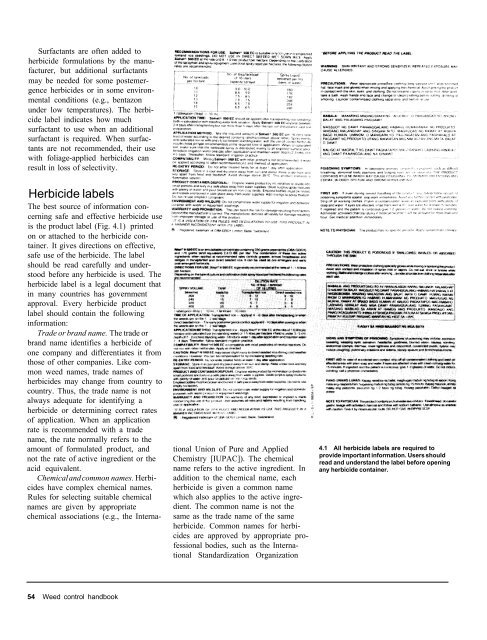A handbbok on Weed Control in Rice.pdf
A handbbok on Weed Control in Rice.pdf
A handbbok on Weed Control in Rice.pdf
Create successful ePaper yourself
Turn your PDF publications into a flip-book with our unique Google optimized e-Paper software.
Surfactants are often added to<br />
herbicide formulati<strong>on</strong>s by the manu-<br />
facturer, but additi<strong>on</strong>al surfactants<br />
may be needed for some postemer-<br />
gence herbicides or <strong>in</strong> some envir<strong>on</strong>-<br />
mental c<strong>on</strong>diti<strong>on</strong>s (e.g., bentaz<strong>on</strong><br />
under low temperatures). The herbi-<br />
cide label <strong>in</strong>dicates how much<br />
surfactant to use when an additi<strong>on</strong>al<br />
surfactant is required. When surfac-<br />
tants are not recommended, their use<br />
with foliage-applied herbicides can<br />
result <strong>in</strong> loss of selectivity.<br />
Herbicide labels<br />
The best source of <strong>in</strong>formati<strong>on</strong> c<strong>on</strong>-<br />
cern<strong>in</strong>g safe and effective herbicide use<br />
is the product label (Fig. 4.1) pr<strong>in</strong>ted<br />
<strong>on</strong> or attached to the herbicide c<strong>on</strong>-<br />
ta<strong>in</strong>er. It gives directi<strong>on</strong>s <strong>on</strong> effective,<br />
safe use of the herbicide. The label<br />
should be read carefully and under-<br />
stood before any herbicide is used. The<br />
herbicide label is a legal document that<br />
<strong>in</strong> many countries has government<br />
approval. Every herbicide product<br />
label should c<strong>on</strong>ta<strong>in</strong> the follow<strong>in</strong>g<br />
<strong>in</strong>formati<strong>on</strong>:<br />
Trade or brand name. The trade or<br />
brand name identifies a herbicide of<br />
<strong>on</strong>e company and differentiates it from<br />
those of other companies. Like com-<br />
m<strong>on</strong> weed names, trade names of<br />
herbicides may change from country to<br />
country. Thus, the trade name is not<br />
always adequate for identify<strong>in</strong>g a<br />
herbicide or determ<strong>in</strong><strong>in</strong>g correct rates<br />
of applicati<strong>on</strong>. When an applicati<strong>on</strong><br />
rate is recommended with a trade<br />
name, the rate normally refers to the<br />
amount of formulated product, and<br />
not the rate of active <strong>in</strong>gredient or the<br />
acid equivalent.<br />
Chemical and comm<strong>on</strong> names. Herbi-<br />
cides have complex chemical names.<br />
Rules for select<strong>in</strong>g suitable chemical<br />
names are given by appropriate<br />
chemical associati<strong>on</strong>s (e.g., the Interna-<br />
54 <strong>Weed</strong> c<strong>on</strong>trol handbook<br />
ti<strong>on</strong>al Uni<strong>on</strong> of Pure and Applied<br />
Chemistry [IUPAC]). The chemical<br />
name refers to the active <strong>in</strong>gredient. In<br />
additi<strong>on</strong> to the chemical name, each<br />
herbicide is given a comm<strong>on</strong> name<br />
which also applies to the active <strong>in</strong>gre-<br />
dient. The comm<strong>on</strong> name is not the<br />
same as the trade name of the same<br />
herbicide. Comm<strong>on</strong> names for herbi-<br />
cides are approved by appropriate pro-<br />
fessi<strong>on</strong>al bodies, such as the Interna-<br />
ti<strong>on</strong>al Standardizati<strong>on</strong> Organizati<strong>on</strong><br />
4.1 All herbicide labels are required to<br />
provide important <strong>in</strong>formati<strong>on</strong>. Users should<br />
read and understand the label before open<strong>in</strong>g<br />
any herbicide c<strong>on</strong>ta<strong>in</strong>er.











